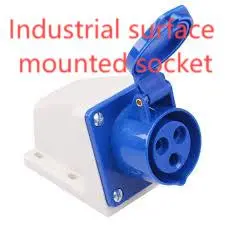Choose a test user to login and take a site tour.






4 minutes, 37 seconds
-3 Views 0 Comments 0 Likes 0 Reviews

Modern facilities need dependable power interfaces, and an Industrial surface mounted socket positioned with foresight can prevent frequent failures and costly downtime. Early-stage design teams also find that an Industrial surface mounted socket matched to load profiles and environmental exposures reduces retrofit needs and simplifies long-term maintenance planning.
Start by mapping the specific uses the outlet will serve. Determine continuous current, peak and inrush conditions, and whether the point will feed motors, lighting, or control equipment. Account for duty cycle and frequency of mating events; connectors exposed to frequent plug/unplug cycles require more robust contacts and retention mechanisms. Also note proximity to traffic, potential physical impact, and whether the outlet should be tamper-resistant or lockable for safety and compliance.
Material selection dictates longevity. For heavy industrial sites, metal housings with corrosion-resistant finishes and plated contacts resist wear and chemical attack. In environments where weight or non-conductivity matters, reinforced polymers with UV and impact stabilization are preferred. Pay attention to contact metallurgy and plating to reduce oxidation and maintain low contact resistance. Ingress protection at the enclosure and gland level should be specified to prevent dust ingress and water penetration that can degrade both insulation and mechanical parts over time.
Choose products with installer-focused details that reduce on-site labor: pre-punched mounting templates, captive fasteners, removable gland plates, and clear internal labeling. These features make wiring neater, speed commissioning, and lower the likelihood of improper field modifications that compromise sealing. Consider modular mounting brackets and compatible accessory kits that let technicians swap in surge suppression modules or blanking plates without replacing the entire unit.
Even relatively low-power outlets can create localized heating when under continuous load. Plan internal layout to separate heat-generating devices from sensitive electronics, and leave convection paths for passive cooling. For higher dissipation scenarios, integrate filtered fans, thermostatic blowers, or compact heat-exchange devices that preserve enclosure protection. Proper conductor sizing, tidy cable routing, and avoiding tight cable bundles all contribute to lower temperature rise and longer service life for connected equipment.
Implement a scheduled inspection routine: verify gasket compression, confirm torque on external fasteners, and inspect for discoloration or moisture marks near terminations. Maintain a small stock of replacement gaskets, standard fasteners, and common gland sizes to speed emergency repairs. Keep clear as-built records of any penetrations or accessory additions so future teams avoid undoing seals. When planning procurement, evaluate total cost of ownership—higher-quality components and easier serviceability often reduce lifecycle expenses compared to lower-cost, hard-to-service alternatives.
Confirm that chosen products meet regional safety standards and have appropriate certifications. Use tamper-proof options where public access is possible, and position outlets at ergonomic, visible locations to facilitate quick visual checks. Provide clear circuit labeling and color coding to minimize human error during maintenance. In temporary installations, favor surface-mounted options that allow rapid reconfiguration without structural changes to walls or finishes.
Deploying well-specified surface-mounted outlets improves uptime, reduces field rework, and enhances worker safety. By matching mechanical design, sealing, and thermal strategy to the actual site conditions, teams create reliable power points that stand up to industrial use. For product ranges, technical resources, and detailed specification guidance, visit www.nante.com

Share this page with your family and friends.